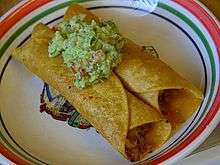Taco stand
A taco stand or taqueria is a food stall, food cart or restaurant that specializes in tacos and other Mexican dishes. The food is typically prepared quickly and tends to be inexpensive.[1] Many various ingredients may be used, and various taco styles may be served. Taco stands are an integral part of Mexican street food. Tacos became a part of traditional Mexican cuisine in the early 20th century, beginning in Mexico City, as what had been a miner's snack began to be sold on street corners in the city.[2] Shops selling tacos have since proliferated throughout Mexico and other areas with a heavy Mexican culinary and cultural influence, including much of the Western United States and most other larger American cities.[3]:4–5 More typical taquerías specialize in tacos, as expected, but in some localities it can be used to refer to restaurants specializing in burritos, where tacos themselves are less of a point of emphasis.[3]:139–148
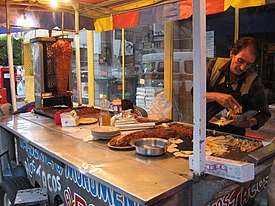
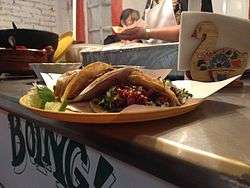
In Mexico, taco stands are commonly referred to as taquerías, because originally a taquería was typically a street vendor. However, many taquerías today are restaurants located in buildings. Taco stands may be located at roadsides[4] and in areas where people gather, such as at outdoor mall areas. Taco stands are typically located outdoors, although the term is also used at times to refer to taco restaurants. Some taco stands are temporary operations, set-up for events such as fairs[5] and festivals.[4]
Fare

Meats used include beef (such as carne asada and cabeza), pork (such as al pastor),[6] goat meat (such as tacos de birria), shrimp and fish, as used in fish tacos. Additional ingredients used include cheese, salsa, guacamole, sour cream, various vegetables such as onion and cilantro, and hot sauce, among others.[1]
By location
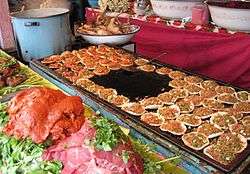
Mexico
Taco stands are common in Mexico.[7][8] For example, Jalisco, Mexico has a diverse variety of taco stands in many of its neighborhoods.[1] In Banderas, taco stands serve as gathering places for local residents, and stands develop reputations based upon variables such as food quality and variety.[1]
El Taco de la Ermita is a popular outdoor taco stand in Baja California, Mexico that serves a diverse variety of gourmet-style tacos.[9] Wait times can be an hour or longer, and the stand typically has an armed security guard on premises to maintain order.[9]
United States
In the United States, some brick-and-mortar restaurants may be referred to as taco stands. Some American chefs and service industry professionals have left their employment positions to open their own taco stands.[10][11][12]
Ninfa Laurenzo, founder of the Ninfa's restaurant chain, started out running a single taco stand in Houston, Texas.[13]
Prior to establishing the Taco Bell restaurant chain, Glen Bell, the company's founder, opened a small chain of taco stands named Taco-Tia in San Bernardino, California.[14][15][16][17][18] Bell owned and operated a hamburger stand prior to opening Taco-Tia.[18] In 2012, Taco Bell sold over 2 billion tacos annually, and had around 6,500 locations in all U.S. states and in several countries.[18]
California
Due to its proximity to the Mexican border California is home to many taco trucks. Although it is famed for its fusions of flavors within this cuisine, perhaps the most famous one is the Korean taco.[19] [20]

The Cielito Lindo Food Stand in Los Angeles, California is well known for its taquitos, and has been in business since the 1930s.[18]
Tito's Tacos is a family-owned taco stand in Culver City that has been in operation since 1959.[22] Featuring a short menu that has not changed in decades,[23] the stand sells American-style hard-shell tacos filled with shredded beef and topped with shredded iceberg lettuce, and cold, grated cheddar cheese.[24][25] It has a loyal customer base and is frequently seen with long lines, though the lines "move quickly".[24]
Henry's Tacos was a well-known taco stand restaurant in North Hollywood, California that was in operation for 51 years.[26] It went out of business in January 2013.[26]
Prior to establishing Jimboy's Tacos, Jim and Margaret Knudson ran a mobile taco stand named Jimboy's Spanish Tacos in a converted trailer at King's Beach, Lake Tahoe, California.[27]
La Reyna is a well-known taco stand in the Arts District of Downtown Los Angeles that serves tacos in front of its identically-named brick-and-mortar restaurant.[6]
Alebrije's Grill Taco Truck based in Santa Ana is a bright pink truck home to the renowned 'Battleship Taco.' This consists of breaded steak, with rice, grilled onions, roasted cactus and hot sauce on a fresh tortilla.
This style of taco has become very popular in the area.[28]
Texas
In August 2006, "hundreds of taco stands" existed in Austin, Texas.[29] AVATACO is a business association of taco stand owners in Austin that was formed circa April 2006.[29]
Wyoming
Taco John's began as a small taco stand in Cheyenne, Wyoming named "Taco House" that opened in 1968.[30]
See also
References
- "Street Eats: Puerto Vallarta Taco Stands". Banderas News. Retrieved September 16, 2015.
- Jeffrey M. Pilcher (2012). Planet Taco: A Global History of Mexican Food. New York: Oxford University Press. pp. 4–10. ISBN 978-0-19-974006-2.
- Gustavo Arellano (2012). Taco USA: How Mexican Food Conquered America. New York: Scribner. ISBN 978-1-4391-4861-7.
- Lighty, Record-Eagle/Tessa (June 26, 2015). "Roadside taco stand sprouts from produce business". Traverse City Record-Eagle. Retrieved September 16, 2015.
- article, Submitted (September 16, 2015). "Taco stand proves successful". Reporter-Times. Retrieved September 16, 2015. (subscription required)
- Elliott, F. (2015). Los Angeles Street Food: A History from Tamaleros to Taco Trucks. American Palate. History Press. p. 63. ISBN 978-1-62585-516-9.
- Karen Hursh Graber. "Wrap It Up: A Guide to Mexican Street Tacos (Part One of Two)". Mexico Connect. Retrieved 17 February 2016.
- Karen Hursh Graber. "Wrap It Up: A Guide to Mexican Street Tacos Part II: Nighttime Tacos". Mexico Connect. Retrieved 17 February 2016.
- Schneider, D.; Remington, S. (2014). Amor y Tacos: Modern Mexican Tacos, Margaritas, and Antojitos. Stewart, Tabori & Chang. p. PT 15–16. ISBN 978-1-61312-122-1.
- "Why Noma's Pastry Chef Left to Open a Taco Stand". Bon Appétit. July 1, 2015. Retrieved September 16, 2015.
- "Once Madonna's 'butler,' Edgar Vazquez is now opening a taco stand on 53rd". WGN Radio – 720 AM. July 17, 2015. Retrieved September 16, 2015.
- Kahn, Howie (June 22, 2015). "Ex-Noma Chef Opens Taco Stand in Copenhagen". The Wall Street Journal. Retrieved September 16, 2015.
- "Ninfa Laurenzo: Taco Maker Turned Millionaire". NBC Learn. May 23, 1981. Retrieved September 16, 2015.
- Stavans, I. (2011). Mexican-American Cuisine. The Ilan Stavans Library of Latino Civilization. ABC-CLIO. p. 131. ISBN 978-0-313-35822-7.
- Johansen, L.T. (2012). Fast Food Vindication. J. Murray Press. p. PT 43. ISBN 978-0-578-11043-1.
- Snapp, Mike (October 1979). "M,ill,ionaires". Orange Coast Magazine. p. 47. Retrieved 18 September 2015.
- Moskin, Julia (April 30, 2012). "North of the Border, It's Everyone's Mexican Food". The New York Times. Retrieved September 16, 2015.
- Miranda, Carolina (April 23, 2012). "The California Taco Trail: 'How Mexican Food Conquered America'". NPR.org. Retrieved September 16, 2015.
- Matano, Angela (2015-04-28). "Fusion Food". Los Angeles Magazine. Retrieved 2019-12-12.
- Farley, David. "The taco that's taking the US by storm". www.bbc.com. Retrieved 2019-12-12.
- Gustavo Arellano (16 April 2013). Taco USA: How Mexican Food Conquered America. Simon and Schuster. pp. 154–156. ISBN 978-1-4391-4862-4.
Dotinga, Randy (8 October 2014). "'This Is What We Eat': A Look at Mexican Food's Roots in San Diego". Voice of San Diego. Retrieved 23 June 2018.
Alice, Matthew (16 March 2000). "How many variations are there of the fast-food Mexican restaurant Roberto's?". San Diego Reader. Retrieved 23 June 2018. - Trinh, Jean (December 16, 2016). "Tito's Tacos Famous Red Salsa, 57 Years in the Making". KCET. Retrieved May 19, 2019.
- Thornburgh, Nathan (August 26, 2012). "Plates of the Union: Tito's Tacos". Roads & Kingdoms. Retrieved May 19, 2019.
- Gold, Jonathan (July 23, 1992). "Man Bites Taco". Los Angeles Times. Retrieved May 19, 2019.
- "How Tito's Tacos Became LA's Favorite Hardshell Taco (video)". Food Insider. December 23, 2018. Retrieved May 18, 2019.
- Smith, Dakota (January 13, 2013). "Henry's Final Taco". Huffington Post. Retrieved September 16, 2015.
- Creative, Design by Magma. "Our Story". Jimboy's Tacos. Retrieved September 16, 2015.
- "The California Taco Trail: 'How Mexican Food Conquered America'". NPR.org. Retrieved 2019-12-12.
- May, Michael (August 11, 2006). "The Taco Kings, Besieged". The Austin Chronicle. Retrieved September 16, 2015.
- Derdak, T. (2004). International Directory of Company Histories. International Directory of Company Histories. St. James Press. pp. 367–369. ISBN 978-1-55862-508-2.
Early History: From Taco Stand to Taco John's Chain. The sprawling restaurant chain dubbed Taco John's was born as a single, tiny taco stand. The "Taco House" as it was called, opened in 1968 in Cheyenne, Wyoming. It was started by a ...
External links





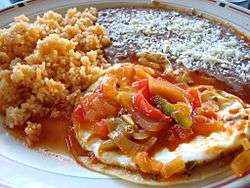
.jpg)
